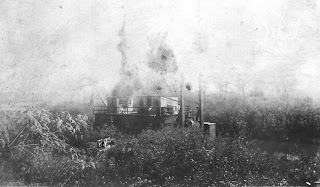I've posted many aerial photos of Sugar Land in the past, but I don't think I've ever posted these. They show much of the town as it was in 1940 and 1953.
The first aerial below shows a northeastward view of the town. You can see that Mayfield Park is hardly developed. In fact, the north end of the subdivision stayed undeveloped until 1953 when Sugarland Industries sold lots for home sites. Charlie White's first restaurant appears on the south side of Highway-90A across from the commercial district. Residents of my mother's generation still refer to it as 'the root beer stand.'
Notice that the wooden stands on the east side of Kempner Field appear in the photo. I always thought they were constructed in 1947, but that is incorrect. Those stands (plus lights) were completed just before the 1939 football season. (I've often used the stadium configuration to date photos.)
The eastern end of Imperial Boulevard appears in this picture, too.
The first aerial below shows a northeastward view of the town. You can see that Mayfield Park is hardly developed. In fact, the north end of the subdivision stayed undeveloped until 1953 when Sugarland Industries sold lots for home sites. Charlie White's first restaurant appears on the south side of Highway-90A across from the commercial district. Residents of my mother's generation still refer to it as 'the root beer stand.'
Notice that the wooden stands on the east side of Kempner Field appear in the photo. I always thought they were constructed in 1947, but that is incorrect. Those stands (plus lights) were completed just before the 1939 football season. (I've often used the stadium configuration to date photos.)
The eastern end of Imperial Boulevard appears in this picture, too.
The next photo shows the Humble service station across Highway-90A from the train depot. The first station I remember (located on the southwest corner of the intersection of Highway-90A and Brooks Street) was built in 1942. You can see that location is vacant in this picture.
The old Sealy Mattress building - later the initial location of the Marshall Canning Company - appears on the northwest corner of Sugar Land Street (now Kempner) and Main Street. The old Imperial Inn, which burned down in 1947, is across Highway-90A on the east bank of Oyster Creek. Also, notice what appears to be vegetable crops in the area that became Brookside. Cotton grew in that field when I was growing up.
The next aerial, also taken in 1940, shows an eastward view from the west side of town. You can see more of Imperial Blvd. in the foreground with the town dairy on the banks of Oyster Creek on the left side of the picture. Highway-90A is a two-lane road; it would expand to 4 lanes in 1947.
The building on the north boundary of the refinery next to Oyster Creek is the site of the sugar mill built in 1843 by the Williams brothers and later taken over by the Kyle and Terry families. Edward Cunningham completely remodeled the mill in the late 1880s - I presume the building in this picture is the same structure. It ceased operation as a sugar mill in 1928 when local growers stopped cultivating sugar cane. Imperial repurposed the building for other uses in the refining process. It was taken down in the early 1960s. I hope to learn more about that in the future.
The final aerial below was taken in the summer of 1953. The view is above the east side of town looking westward. Note the new shopping center (completed the year before), the Humble station and Sugar Land Motor Company on the corner of Brooks and Highway-90A, and the Palms Theater (completed in 1949). You can see that the highway is now 4 lanes wide.














































